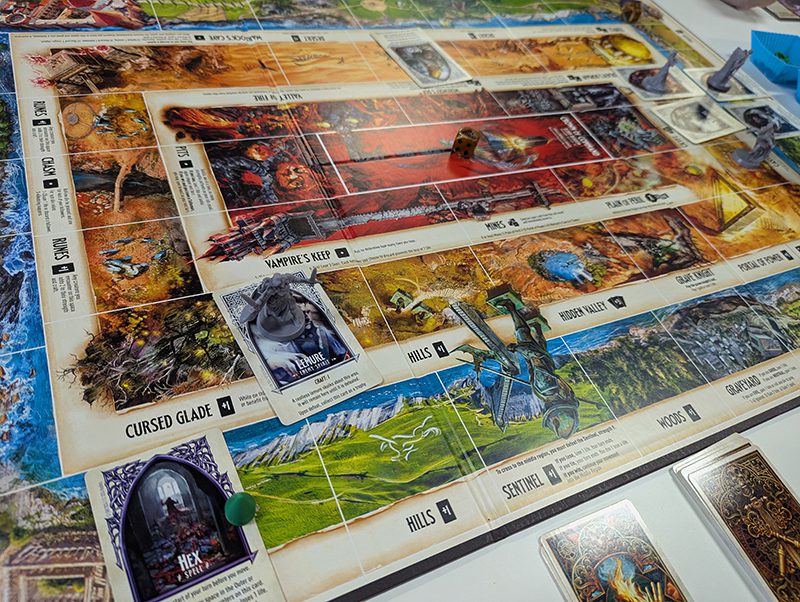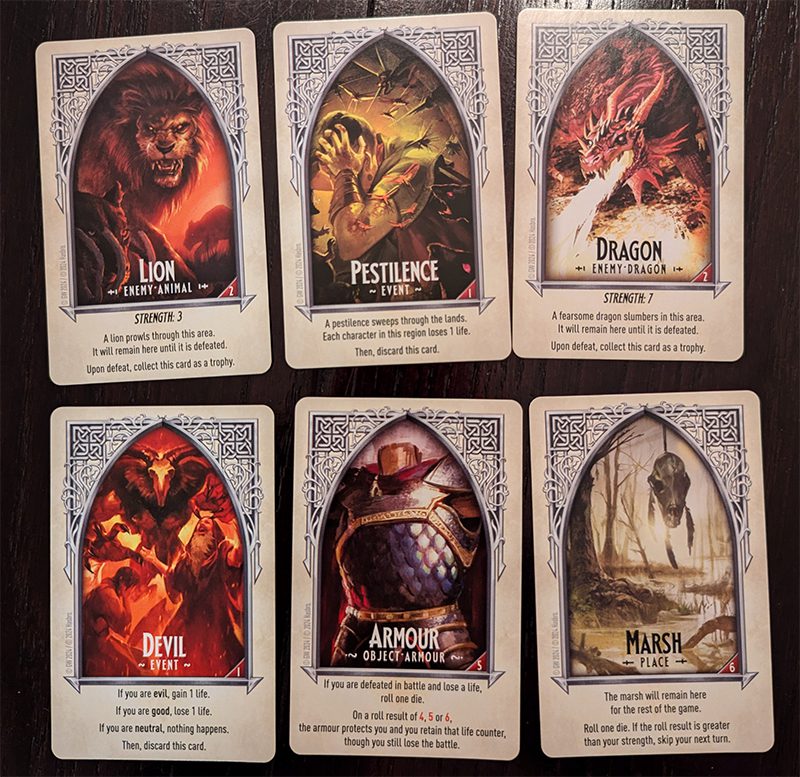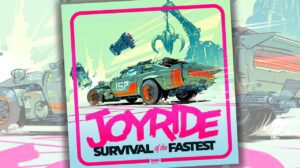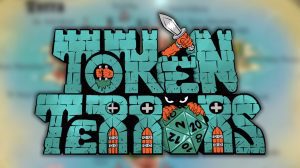Disclosure: Meeple Mountain received a free copy of this product in exchange for an honest, unbiased review. This review is not intended to be an endorsement.
Whenever the discussion of adventure board games comes up, the game Talisman is always mentioned. A relic from the 80s, Talisman was originally designed to mimic the adventures of role playing games in a condensed experience and light rules. The popularity could not be ignored, as the game had several editions since its inception.
Despite the rich legacy behind Talisman, it wasn’t viewed favorably by the gaming public at large. Its roll-and-move mechanics, heavy reliance on luck, and notoriously long playtime have often been cited as significant drawbacks. The game’s endurance seemed to rely more on nostalgia than on its merits as a tabletop experience. Personally speaking, I have never seen this game played at conventions and rarely requested in public gaming groups. While it undoubtedly retains a dedicated fanbase, this following appears reluctant to expand.
This is where the 5th edition of Talisman takes the helm. A good portion of the game’s marketing was committed to informing the world of some changes to “speed up” the game. Being turned into a Toad was no longer a death sentence, as it was akin to skipping a turn instead of outright destroying your progress. Specific board game spaces were adjusted to keep the pace flowing along. Perhaps the most interesting change was the end game condition, where you simply need to defeat the Elder Dragon at the final space instead of draining everyone’s life like the original edition.

A Legacy of Adventure
Do all of these changes cultivate an enjoyable experience that even non-fans of Talisman can appreciate? Sort of.
Of course, like any other board game review, I have to give some context of what’s going before I delve into my opinions. As mentioned, the purpose of the game is to reach the final space on the board to defeat the Elder Dragon. At the start of the game, you pick a character with their own game-breaking ability and stats, and go on from there.
The board is divided into three regions: Outer, Middle, and Inner. You start in the Outer region, the “easy” region, and travel around the region to make yourself stronger to venture to the Middle and eventually the Inner region for the final showdown.
Turns are extremely easy. You roll a die and that’s the number of spaces you must move, and your only decision is either moving to the left or right. Once you land a space, you interact with it. For the most part, you are simply drawing a card to follow its instructions, while some spaces will have direct instructions written on them.
The cards themselves can take on various forms. Equipment cards enhance your character’s abilities or statistics. Followers, while similar, typically focus on granting special powers. Place cards introduce permanent effects to specific board spaces, creating points of interest for players to interact with. Event cards trigger immediate occurrences and are then discarded. Finally, monster cards initiate combat encounters.
Duels and Dice
Combat is simple as movement. Monsters will either attack with Strength or Craft, and your character will respond with the same stat. Roll a die for yourself and another one for the monster. Add your die result with your stat, and whoever is higher wins the combat. If you lose, you lose a life, and if you win, you take the monster as a “trophy” and can trade it in to boost a stat. This is going to be your main way of growing stronger.
But what happens if you land on a space with another player? I didn’t say this game was friendly. Instead of encountering the space, you can encounter the player and like fighting a monster, it’s a roll of the die plus a stat. The defeated player faces consequences such as losing a life or forfeiting a coin or item to the victor. However, as a small consolation for this setback, the losing player receives a Fate token
Fate token is an interesting addition and was originally introduced in the 4th edition of Talisman. They serve two functions. One is a straightforward reroll opportunity for anything outside of movement. For movement purposes, after rolling the die, you can spend a Fate token to change the movement die to whatever number you like, giving you a tad more precision when traversing around the board.

The Hero’s Journey
All of these changes sound nice, so does this make Talisman a worthwhile experience after all these years? No. If anything, I wish this edition had more radical changes. It feels like they had to subdue any potential ideas to appease a crowd that refuses to budge. Even during the game’s promotional period, I observed online discussions where purists objected to alterations to the endgame and toad mechanics, as if they were good ideas forty years later.
What’s also not a good idea is creating a “race to the objective” board game with numerous ways to lose progress. If you are designing a board game where players have to reach an end goal, the “worst” player interaction should be halting progress. Unfortunately for Talisman, there are so many ways to backtrack that could take up dozens of minutes to catch up.
For example, spell cards are mainly used to mess around with both the board spaces and other players. A lot of them are harmless, such as removing cards on the board or forcing a player to skip a turn. However, there are some places and spells that can outright remove stat progression such as Strength from a player. All those times you fought and won? That’s all gone.

Perils on the Path to Glory
Even if the designers had removed all the mechanisms that hinder progression, the game’s core issues would persist. Your main way of growing in power is by fighting and you can only fight if you draw monsters. If you don’t, you simply cannot move forward in the game state. In my multiple playthroughs for this review, I consistently failed to accumulate enough power to even approach the Inner Region and trigger the endgame, simply due to a lack of monster draws. A more thoughtful game design might have incorporated dedicated board spaces that offer alternative paths to advancement, mitigating the impact of unfavorable card draws. However, such innovation seems beyond the scope of Talisman‘s traditional framework.
While many fans of Talisman are likely going to disregard my complaints, I can’t ignore the consequences here. For my three playthroughs, I had to get three different groups since no one wanted to go through this ride a second time. That is a dozen people, which says a lot for a game’s appeal to the masses. I’m not inherently opposed to games that incorporate luck or even roll-to-move mechanics; I don’t consider myself a board game elitist. Yet it’s crucial to note that when designing a game heavily reliant on chance, there should be safeguards to mitigate a “worst-case scenario.” Unfortunately for Talisman, it simply doesn’t acknowledge the issue at all.
In the end, Talisman’s 5th edition fails to address the fundamental flaws that have long plagued this venerable game. While I applaud the attempt to streamline the experience, they don’t go far enough. The game’s stubborn adherence to outdated mechanics makes for an experience that is more endurance test than enjoyable adventure. Life of adventuring is full of luck but there does need to be systems in place to keep the experience consistent for all participants at the table. Ultimately, Talisman serves as a reminder that sometimes, even with attempts at refinement, some games simply refuse to grow up.












Thank you for your thoughtful review. As a Talisman newbie (never played it before 5th edition but had definitely heard about it and was excited to give to it a spin). I am a little puzzled by your contradictory conclusion: “Talisman’s 5th edition fails to address the fundamental flaws that have long plagued this venerable game.”
It’s curious that a game that possesses the flaws you cited above has achieved enough commercial success to warrant a fifth edition (plus the copious amounts of past expansions and the already-announced 1st expansion for the current edition which will arrive in October). Beyond a dedicated demographic of players, what has sustained the publisher’s ROI over the course of the last 40 years since it was first released? Is Talisman a reasonable “gateway game” for players who lack experience with the forms of boarding you and I likely take for granted? At ~ $55 MRSP, it seems a reasonably priced game for people to try out and later trade for something else. Perhaps it’s attractive to players who have considered dabbling in a DnD-style adventure game but were intimidated by the bling and price point of Descent:LotD.
Your central complaint seems to be the punishing RNG effects (and there are undoubtedly some issues here) that are not addressed with the limited changes made to the Fate tokens, the Toad burden or the endgame conditions. However, I inferred that you felt that 5th edition was an improvement over its predecessor, even if the designer’s incremental approach was not to your liking. Your proposed alternative pathways of progression may yet materialize in future expansions, and the 1st expansion will include a coop mode that’s not been done before in previous editions.
I realize like this sounds like I’m dismissing your critique, but actually I’m trying to resolve my own cognitive dissonance with T5 because we have not had the negative experiences you’ve reported (or at least not yet). The mechanisms are cliched, the turns tend to be quite short and the player agency is decidedly marginal. Despite these limitations, we still enjoyed ourselves over the course of several games. Will Talisman become a regular thing with our group? Perhaps not now, but I will continue to watch with cautious optimism as further content for 5th edition is released.
By way of comparison, I was thinking about another flawed-but-venerable game with GF9’s 2019 re-release of AH’s 1979 Dune. The GF9 edition is aesthetically appealing, has a few material upgrades and a reasonable price point- however, it has also failed to address various rules obscurities and edge cases going on for 45 years (e.g. some specific uses for the Karama card). Perhaps nostalgia allows players to be more forgiving of flawed mechanics, or for those of us who do not have such a history with game we managed to avoid disappointment because we set our initial expectations appropriately.
Would love to read your follow-up when Talisman 6th edition eventually lands on shelves.
I welcome some form of discussion, even if it doesn’t agree with me, so no need to worry about this. I’ll admit I might sound a little harsh here.
Regarding the success of Talisman. While I cannot deny the commercial success of Talisman, the financial success of the game doesn’t determine the game’s quality. What’s often the case for the game’s success is the marketing and the image it portrays. In Talisman’s case, it’s a product of its time tied to childhood and nostalgia. This was a game released in the 80s with Games Workshop pushing it to the masses. Even in the 80s and early 90s, Games Workshop was a big company that drew the eyeballs of nerds everywhere, including yours truly.
While this might sound like I’m speaking out of nowhere, one simply has to look at who is buying and playing it. I’ve attended plenty of gaming conventions and gaming meetups, and no one brings out Talisman to these groups. Mainstream board game YouTubers like Dice Tower will likely not touch it. Most of the content I’ve seen for this game comes from channels that are already fans of Games Workshop.
To keep it simple, while I do view this as an improvement over the prior editions, I doubt it’s going to penetrate to the general gaming public. The game is designed for Talisman fans first with little care for those outside of the bubble like myself. I tried to give this game a shot several times as I have done with previous games I disliked. It isn’t a terrible game, but time is not something you get back, and Talisman 5th Edition isn’t going to be my 1st or 10th pick with all the numerous games out there. For adventure games, there is already plenty of options from the complex Mage Knight, the cooperative Andor, or the upcoming Defenders of the Realm remake
I think what you are not explaining about this game (and the reason it has been so successful for so many decades) is that it fills an important and demanded space and that there is no other notable game filling this space.
What important and demanded space am I talking about?
– Rules that are involved but not overly complex (basically, do what the card or space says).
– Simple RPG-like set up where you can both advance and personify your fantasy character.
– Competitive play that has a lot of randomization but also a dash of lightweight strategy and tactics.
– A huge, beautiful, fantastic map that is unlike any other board game map that I’ve ever seen.
This is not a game for someone who wants complex strategy. This is a game for middle school kids or advanced elementary kids, or a group of adult friends who are, for at least a couple of hours, wanting a funny, competitive, immersive fantasy adventure that makes you think a little bit but not too much.
What other game fills that space?
– That is competitive?
– That gives you a fantastic character to personify and advance?
– That gives you a huge fantasy map with dozens of different spaces to explore and interact with?
– That makes you think but not too much?
– That a group of 5th graders can play without any help from their parents?
In Dungeons and Dragons, there are some players who love min-maxing, optimization and tactical combat. There are other players who just love to roll dice and role play.
Talisman is definitely more for the latter type.